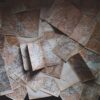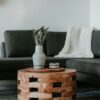Do you have an old piece of furniture just waiting for a new life? Let me share the transformation of my latest thrift store find—a coffee table—into a charming farmhouse-style centerpiece. As someone who loves giving furniture a second chance, this project allowed me to blend creativity and functionality while ensuring it was safe and stylish for my home. Join me as I recount the journey of turning a forgotten table into a cherished part of my living space.
A Diamond in the Rough: The Thrift Store Discovery
Walking into a thrift store is always an adventure. I never know what treasures I’ll find hidden among the shelves and stacks. On this particular visit, I discovered a coffee table that instantly caught my eye because of its chunky legs. These hefty supports hinted at both stability and potential, perfect for a farmhouse-style makeover. My initial thought was to use these legs for a new table, preserving their robust allure, or, if possible, refurbish the entire piece.
Considering Safety and Style
When you have children running around, safety becomes as important as style. This was a crucial factor in deciding to refurbish the existing table instead of creating a new one. By keeping the table intact, I avoided any potential sharp edges or unsturdy structures that could result from starting from scratch. Plus, the table’s original build suggested it could withstand years of use with just a little TLC.
Prepping for Transformation: Gathering Supplies
Every successful DIY project starts with a solid plan and the right supplies. I wanted the table to have a rustic yet clean look, and I decided on staining new boards for the top while painting the legs. This would create a visually appealing contrast between the wooden warmth of the tabletop and the crisp brightness of the legs.
Shopping List: What I Used
Here’s a quick rundown of the materials and tools I used to bring my vision to life:
Materials:
- Minwax “Classic Gray” Stain
- Clear polyurethane for protection
- Wooden boards for the tabletop
- Screws for attaching the boards
Tools:
- Wagner Home Decor sprayer for painting
- Electric screwdriver
- Sandpaper for a smooth finish
- Saw (to cut the boards to size)
Everything was sourced primarily from my local home improvement store, making this project both accessible and cost-effective.
Revamping the Legs: A Coat of Paint
The first step in my transformation process was painting those sturdy legs a bright white. This immediately modernized their appearance and allowed them to match my envisioned farmhouse theme. The white paint served as a perfect canvas against which the new wooden tabletop would contrast beautifully.
Using the Wagner Home Decor Sprayer
To ensure a smooth and even coat of paint, I utilized my trusty Wagner Home Decor sprayer. This tool has become indispensable for projects like this, as it provides a uniform finish quickly and efficiently. After a couple of passes with the sprayer, the legs were gleaming and ready to support their new tabletop with style.
Crafting the Tabletop: A Touch of Rustic Charm
Switching my focus to the tabletop, I decided on using wooden boards for a rustic look. I selected Minwax “Classic Gray” Stain, which added a soft, weathered appearance perfect for farmhouse aesthetics.
Cutting and Staining the Boards
The first task was cutting the boards to size. I opted to make them longer than the original tabletop, creating a subtle overhang. This detail added visual interest and contributed to the farmhouse style I was after. The boards were stained separately to avoid any potential drips, allowing me to control the finish and ensure each piece was evenly colored.
Staining Tips for Beginners
If you’re new to staining, here are a few tips:
- Test First: Always test your stain on a scrap piece of wood to see how it interacts with the wood grain and texture.
- Even Application: Use a cloth or a brush to apply the stain evenly, wiping away any excess to avoid blotches.
- Drying Time: Allow sufficient drying time before handling the boards to ensure the stain is fully set.
Assembly: Bringing It All Together
Now that the legs were painted and the boards were stained, it was time to bring everything together. Assembly is a satisfying part of any DIY project as it showcases the fruits of your labor.
Attaching the Boards Securely
Using screws, I attached the boards to the top of the table. The exposed screws not only added to the rustic appeal but also provided a secure, sturdy fit. In fact, I found that these visible screws contributed to the overall aesthetic, enhancing that farmhouse look I aimed for.
Sealing with a Clear Polyurethane Coat
To protect my new tabletop and keep it looking fresh for years to come, I applied a clear polyurethane coat. This vital step ensures the wood can withstand daily use, from coffee mug stains to children’s craft projects, without losing its luster.
Reflections on the Process: Lessons Learned
Transforming this coffee table was not only a hands-on project but also a learning experience. I discovered the joy of combining different textures and finishes and saw firsthand the impact of small details on the overall look. The use of the gray stain was a revelation, and I anticipate employing it in future projects for its subtle yet sophisticated vibe.
Embracing Imperfections
Throughout this process, I embraced imperfections as part of the table’s charm. Farmhouse style thrives on character and authenticity, often found in the natural inconsistencies of wood and the visible handiwork of its creator. Rather than aiming for machine-perfect results, I learned to see the beauty in unique imperfections that tell a story.
Engaging with A Community: Sharing Ideas and Inspirations
One of the most fulfilling aspects of undertaking such projects is sharing them with others. I’ve connected with many fellow DIY enthusiasts who have embarked on similar endeavors, each with their own stories and suggestions.
Reader Interactions and Feedback
Some readers have reached out to share their ideas or ask questions, creating a vibrant exchange of tips and inspiration. From debating stain colors to selecting the right protective finish, these interactions have enriched my DIY journey, reinforcing the sense that crafting and creativity are ever more enjoyable when shared.
Conclusion: A New Lease on Life
In the end, my thrift store find was more than just a project; it was an opportunity to breathe new life into a piece of furniture. The satisfaction of repurposing something old into something beautiful is unparalleled. This farmhouse-style coffee table, with its chunky white legs and rustic gray top, now serves as a centerpiece in my home, testament to the power of creativity and the charm of upcycling.
Next time you come across an old piece of furniture, consider the potential transformation it might hold. With some imagination and a bit of effort, you can create pieces that not only enhance your space but also reflect your unique style and resourcefulness.






